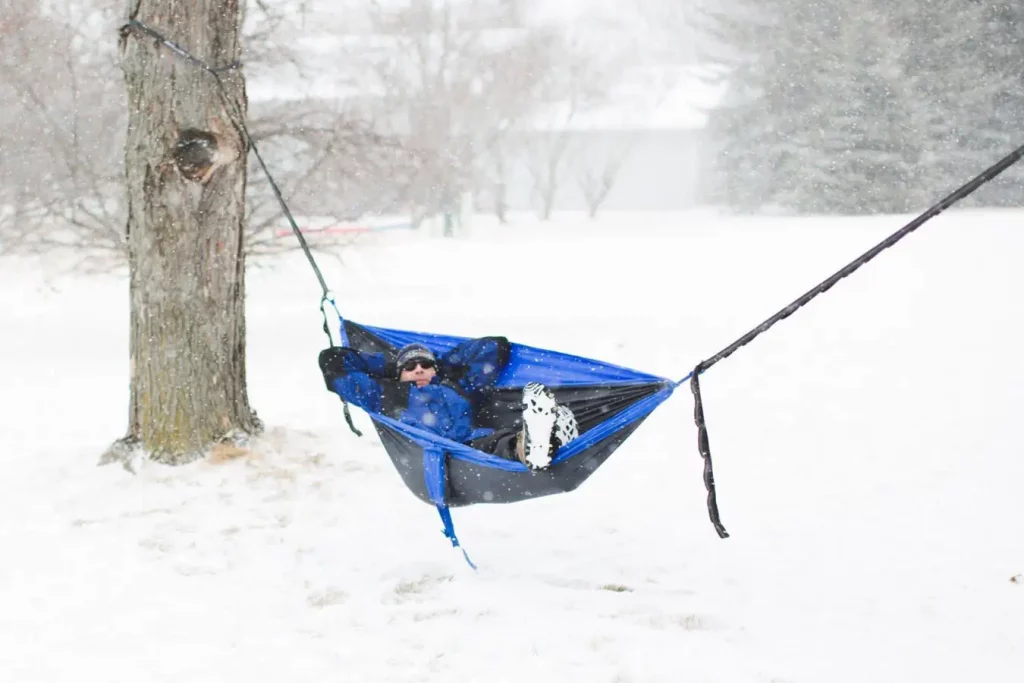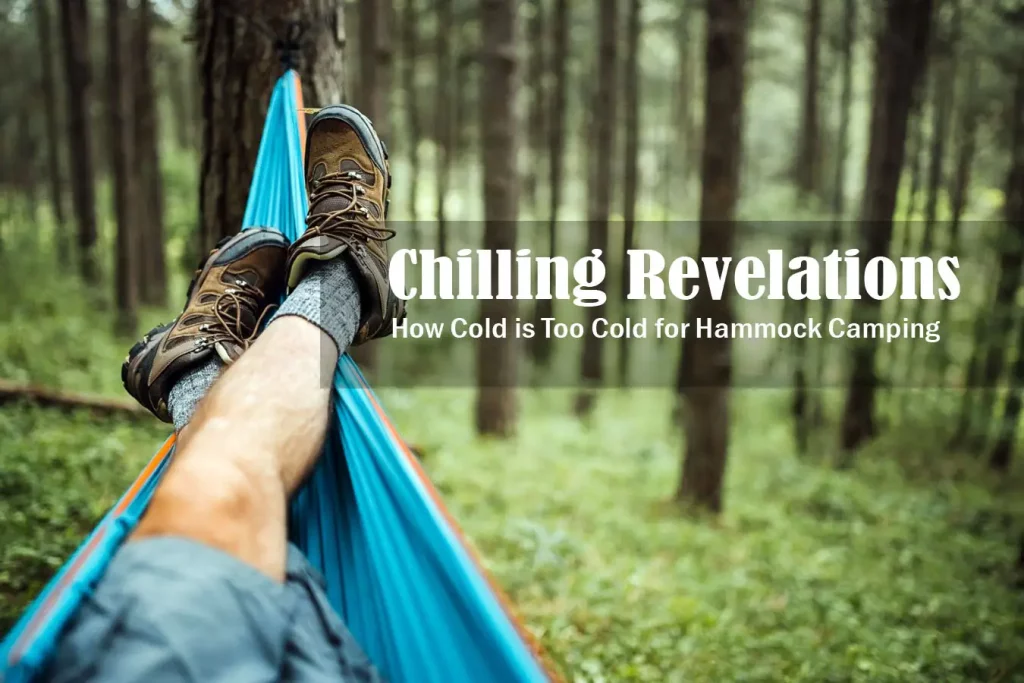Casting your eyes up to a starlit sky, swaying gently with the evening breeze, there’s little to match the serene experience of hammock camping. But as the mercury begins to dip, even the most hardened outdoor enthusiasts might start to question, “How cold is too cold for hammock camping?”
The Cold-Weather Challenge. We’ve all experienced it.
That bone-chilling cold that creeps up, turning a fantastic outdoor adventure into a survival challenge. It’s a common scenario in hammock camping, where the aerial position exposes you to more than just stunning views. So, let’s delve into the crux of the matter and dissect the cold weather challenge.
The Science of Cold: Understanding Temperatures
Measuring Cold: What Do We Mean by “Too Cold”?
When we talk about cold, it’s a subjective experience. Some hardy souls relish the crispness of sub-zero temperatures, while others find a mild chill hard to handle. However, when it comes to hammock camping, we can establish some ballpark figures.
When the mercury falls to 60°F or lower, having an underquilt for your hammock becomes nearly indispensable. Without it, the cool air circulating under the hammock will rob you of your body heat, leaving you shivering in the otherwise cozy confines of your hammock.
The Human Body’s Response to Cold
When exposed to cold, our bodies employ several mechanisms to maintain core temperature, from shivering to redirecting blood away from extremities. In extreme cold, these responses might not be sufficient, leading to risks like hypothermia or frostbite.

Cold and Its Effects on Sleep Quality
Contrary to popular belief, our bodies don’t sleep better in cold conditions. While a slightly cooler room might promote sleep, freezing temperatures can keep you up all night. Besides, your body is too busy trying to keep warm to delve into a deep sleep phase, leaving you feeling less rested come morning.
Hammocks and Cold Weather: The Unique Relationship
The Aerial Dilemma: Wind and Airflow Considerations
Unlike a traditional ground tent, a hammock elevates you off the ground, literally leaving you hanging in the cold. This suspension creates a 360° exposure to wind and cold air, potentially making you lose heat faster than you would on the ground.
The Heat Loss Phenomenon in Hammocks
Think back to that physics lesson on convection: heat tends to move from warmer objects to cooler air. When you’re up in a hammock, the cool air continuously strips away your body heat, resulting in what’s known as “cold butt syndrome” among hammock campers. It’s not just an amusing term but a chilling reality when the temperature plummets.
Hammock Camping: Minimum Temperature Threshold
Recognizing the Lower Limit: How Cold is Too Cold?
While the specific temperature tolerance will vary from person to person, a good rule of thumb is that without proper gear, hammock camping becomes uncomfortable below 70°F. With the right insulation, however, you can push this boundary further down, with some experienced campers reporting comfortable nights even at freezing point.
Determining Personal Comfort Levels
A crucial part of hammock camping in cold weather is understanding your own comfort levels. Try camping in your backyard during different weather conditions to gauge your tolerance, and always ensure you have an exit plan if the cold becomes unbearable.
Know more: How to Keep Meat Cold While Camping
Hammock Camping Gear for Cold Weather
Now we know how cold can be too cold, let’s discuss how to gear up against the chill.
Choosing the Right Hammock for Cold Weather
Not all hammocks are created equal. For cold-weather camping, look for hammocks designed with integrated insulation or ones compatible with aftermarket underquilts.
The Importance of Underquilts and Topquilts
Remember our friend “cold butt syndrome”? An underquilt is your best defense against it. Paired with a topquilt – essentially a sleeping bag designed for hammocks – they provide a cozy cocoon against the cold.
Sleeping Pads and Sleeping Bags: Your Cold-Weather Armor
While traditional sleeping bags may seem inadequate for hammock camping due to compression under body weight, a sleeping pad can provide an additional barrier against heat loss. Choose one with a high R-value for better insulation.
Don’t Forget Your Tarp: Protecting Against Wind and Precipitation
A sturdy tarp isn’t just for warding off rain; it can also serve as a windbreak, reducing the chilling effect of the wind on your hammock.
Learn more: Winter Camping Basics
Essential Techniques for Hammock Camping in the Cold
Even with the best gear, knowing a few cold-weather techniques can go a long way.
Layering: Your Best Defense Against the Cold
Dressing in layers helps trap warm air near your body. Start with a moisture-wicking base layer, add an insulating middle layer, and finish with a waterproof and wind-resistant outer layer.
Proper Hammock Setup to Minimize Heat Loss
How you set up your hammock can impact your warmth. Position your hammock to shield against prevailing winds, and hang your tarp low to block wind and trap heat.
Hydration and Nutrition: Fuelling Your Internal Furnace
Staying hydrated and well-fed can help your body generate heat. Consider high-energy snacks and a warm drink before bedtime.
Dryness is Warmth: Moisture Management Tips
Moisture, whether from sweat or precipitation, can dramatically increase heat loss. Make sure your gear is dry before you settle in for the night.
Safety Considerations for Cold Weather Hammock Camping
The Dangers of Hypothermia and Frostbite
While hammock camping is generally safe, exposure to extreme cold without proper gear can lead to serious health risks like hypothermia and frostbite.
Preparing for Weather Changes
Always check the weather forecast before heading out, and be prepared for unexpected changes. Remember, it’s better to overprepare than to be caught off-guard.
When to Say No: Recognizing Unsafe Conditions
Recognizing when conditions are unsafe for hammock camping is crucial. If the forecast predicts extreme cold, high winds, or severe weather, it might be best to postpone your trip.
Read more: Top 5 Camping Hammocks for Side Sleepers
FAQs About Hammock Camping in Cold Weather
How cold is too cold for a hammock?
Are hammocks good for cold weather camping?
Is 11 degrees too cold for camping?
Is 4 degrees cold for camping?
How cold is too cold for camping?
What is the lowest temperature safe for hammock camping?
What are the most important items for hammock camping in the cold?
What are the signs of hypothermia during hammock camping?
How can I improve insulation in my hammock during winter?
What’s the Lowest Temperature You Can Comfortably Hammock Camp in?
Can I Use My Summer Hammock for Winter Camping?
How Do I Choose the Right Underquilt for Cold Weather?
What Are Some Signs of Hypothermia I Should Be Aware of When Hammock Camping in Cold Weather?
Summary
While hammock camping in cold weather can be challenging, with the right gear and preparation, you can enjoy the great outdoors year-round. Remember to respect your personal comfort levels, and stay safe.
Remember, hammock camping is as much about the journey as the destination. So, stay warm, stay safe, and most importantly, enjoy the ride!
We hope this guide has provided insight into hammock camping in cold weather.
To know more: Flamingos and Pineapples Mean When Camping


